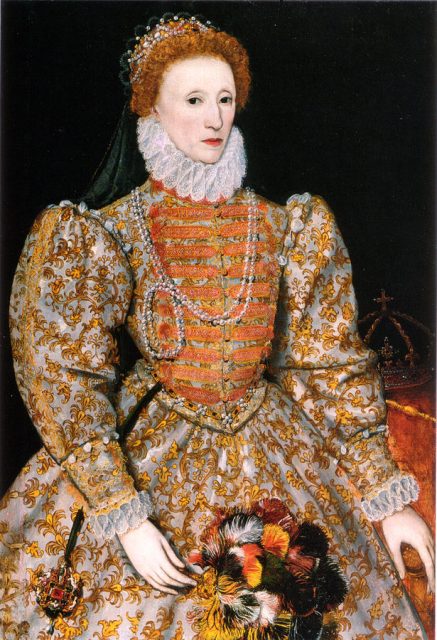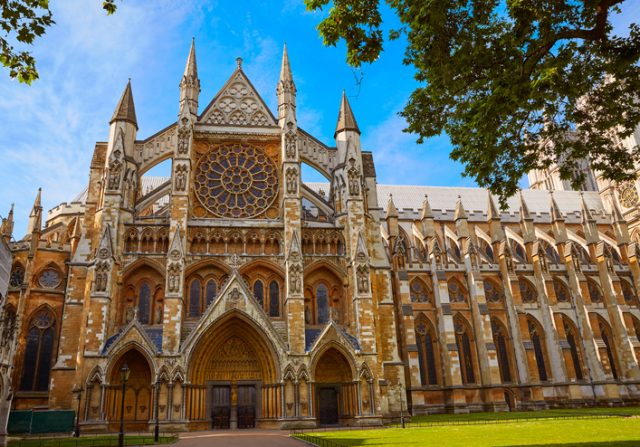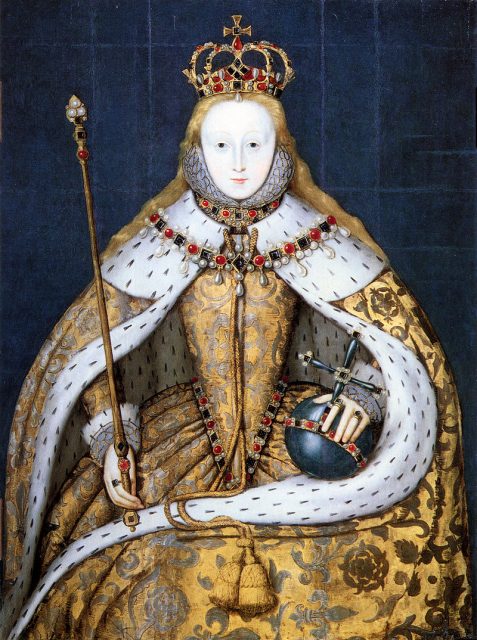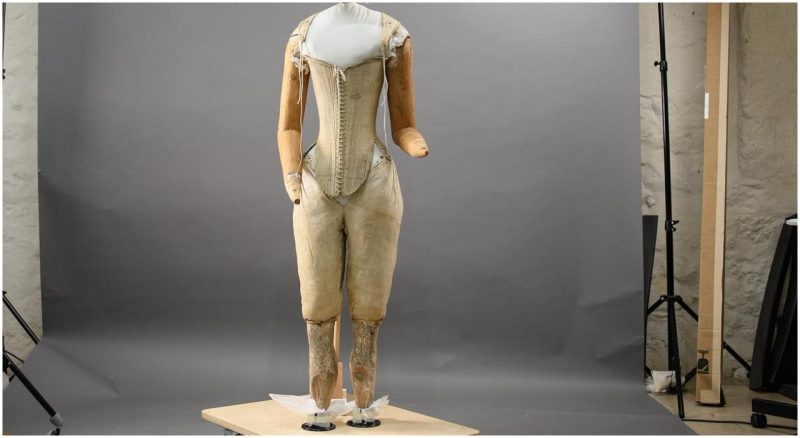The funeral procession of Queen Elizabeth, the “Virgin Queen,” on April 28, 1603, was a day that no one could ever forget.
Elizabeth Tudor, the unmarried younger daughter of Henry VIII, ruled England for 44 years before dying at the age of 69. Her successor was James VI of Scotland, who had Tudor blood running in his veins. James’s mother, Mary Queen of Scots, had been Elizabeth’s second cousin–and she was Elizabeth’s victim, too, executed for treason. But James was perfectly willing to put that aside, to gain the throne of England.
The day of her funeral, Elizabeth’s purple-draped coffin was carried to Westminster Abbey from Whitehall on a hearse drawn by a chariot and horses hung with black velvet. The coffin was topped with a painted wooden effigy of Elizabeth holding a scepter in her hands and a crown on her head. The crowds found the effigy of the Queen quite lifelike.
A witness wrote at the time: “Westminster was surcharged with multitudes of all sorts of people in their streets, houses, windows, leads, and gutters, that came out to see the obsequy, and when they beheld her statue lying upon the coffin, there was such a general sighing, groaning and weeping as the like hath not been seen or known in the memory of man.”

The effigy figure carried through the streets wore a gown that the slender Queen herself could have worn, and underneath it a corset and other underpinnings. That cloth corset was believed to have been created by the Queen’s tailor, William Jones, from a pattern used for bodices she wore while alive.
This June, 415 years after the Queens’ funeral, the public will be able to see the corset at a special exhibition at Westminster Abbey.
The Queen’s Diamond Jubilee Galleries, set more than 50 feet above the Abbey’s floor in the medieval Triforium, will display the corset as one of the treasures of its collection. Once described as offering the “best view in Europe” by English poet John Betjeman, the Triforium has never before been open to the public. There will be about 300 objects on display.

In 1995, the effigy of Queen Elizabeth residing in Westminster was unclothed for study, and once the gown and hoopskirt were removed, the effigy’s corset and drawers were examined. Janet Arnold, an Elizabethan costume historian, spent some time scrutinizing these underpinnings before pronouncing them contemporary to Elizabeth’s death in 1603.
The conservation work performed on the corset to prepare it for display this year was carried out by a team including costume historian Jenny Tiramani, and it revealed a number of previously unknown details. The team discovered that the boning finishes slightly lower on the right-hand side, which would have allowed right-handed Elizabeth greater ease of movement.
Elizabeth I was tall and slender, with a tiny waist and beautiful hands. She inherited her father’s auburn hair but in most other respects she physically resembled her mother, Anne Boleyn, with a long, oval face, olive-tinged complexion, and dark brown eyes. When she was 25, the Venetian ambassador described her: “My Lady Elizabeth is a young woman whose mind is considered no less excellent than her person, although her face is comely rather than handsome, but she is tall and well-formed, with a good skin although sallow.”

The Queen dressed to impress and is said to have owned more than 3,000 gowns, many hand-embroidered and decorated with diamonds and sapphires, and ordered new shoes made for her every week. She had dresses of all colors, but white and black were her favorite colors as they symbolized virginity and purity. Underneath her dress, she wore a corset stiffened with wood or iron, a petticoat, a fathingale, and stockings.
Related story from us: The British royal family hid Crown Jewels from Nazis in a biscuit tin
As befitted the Queen’s reign, her funeral was held with “great pomp and magnificence,” according to a chronicler of the time. There was a parade of over 1,000 mourners proceeding to Westminster. Many of the people watching the effigy rumble by began to weep. One man described her hearse as “a land swimming in water, for round about it there rained showers of tears.”
Nancy Bilyeau, the U.S. editor of The Vintage News, has written a trilogy of novels set in the era of Henry VIII: ‘The Crown,’ ‘The Chalice,’ and ‘The Tapestry.’ The books are for sale in the U.S., the U.K., and seven other countries. For more information, go to www.nancybilyeau.com.
